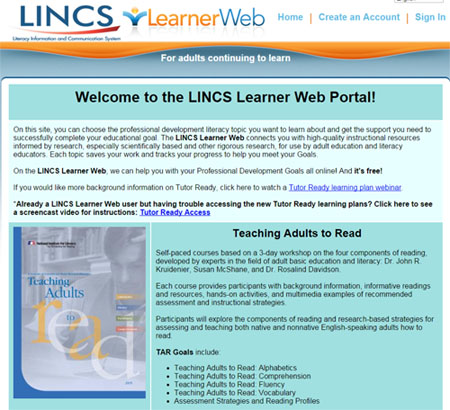- MN ABE Connect
- Archive
- Teaching Adults to Read
Teaching Adults to Read
Marn Frank, Literacy & STAR CoordinatorFor several years, access to self-paced, online courses from Literacy Information Network Communication System (or LINCS) Learner Web has been available under Professional Development in the Reading resource library. All five are based on the research summary Teaching Adults to Read and a three-day workshop developed by adult literacy experts Dr. John R. Kruidenier, Susan McShane, and Dr. Rosalind Davidson.
 I recently found time to review three of them: Teaching Adults to Read: Alphabetics, Fluency, and Vocabulary. They were well worth my time!
I recently found time to review three of them: Teaching Adults to Read: Alphabetics, Fluency, and Vocabulary. They were well worth my time!
To access these FREE courses, go to the LINCS website and set up a screen name, password, and short profile. Because users can select which courses to browse or complete, they all begin with the same overview of the reading process and links to research publications. Full completion of each course will result in a LINCS certificate. Below are short summaries of the courses I reviewed.
Teaching Adults to Read: Alphabetics (2+ hours)
The 58 pages or slides cover basic concepts and resources related to alphabetics research, assessment tools, and teaching strategies. They focus on the alphabetics skills of phonemic awareness, phonological awareness, and phonics or word recognition. There are many videos of an ABE teacher and student and downloads to copy and print from My Stuff.
Teaching Adults to Read: Fluency (2+ hours)
The 45 pages or slides cover basic concepts and resources related to fluency research, assessment tools, and teaching strategies. They focus on the fluency aspects of speed, accurate word identification, phrasing and expression (or prosody). They also make a connection between fluency development and learner persistence. There are many videos of the same ABE teacher and student and downloads to copy and print from My Stuff.
Teaching Adults to Read: Vocabulary (2+ hours)
The 55 pages or slides cover basic concepts and resources related to vocabulary research, assessment tools, and teaching strategies. They recommend a direct vocabulary approach for teaching Tier 2 words (telling pronunciations, roots, suffixes, contexts, and meanings) and building background knowledge. There are several videos of a different ABE teacher and several students and downloads to copy and print from My Stuff.
Newsletter Signup
Get MN ABE Connect—the official source for ABE events, activities, and resources!
Sign UpArticle Categories
- ABE Foundations/Staff Onboarding
- ACES/Transitions
- Adult Career Pathways
- Assessment
- CCR Standards
- Citizenship
- COVID-19
- Cultural Competency
- Digital Literacy/Northstar
- Disabilities
- Distance Learning/Education
- ELA
- Equity/Inclusion
- ESL
- HSE/Adult Diploma
- Listening
- Math/Numeracy
- Mental Health
- Minnesota ABE
- One-Room Schoolhouse/Multilevel
- Professional Development
- Program Management
- Reading
- Remote Instruction
- Science
- Social Studies
- Speaking/Conversation
- Support Services
- Teaching Strategies
- Technology
- Uncategorized
- Volunteers/Tutors
- Writing